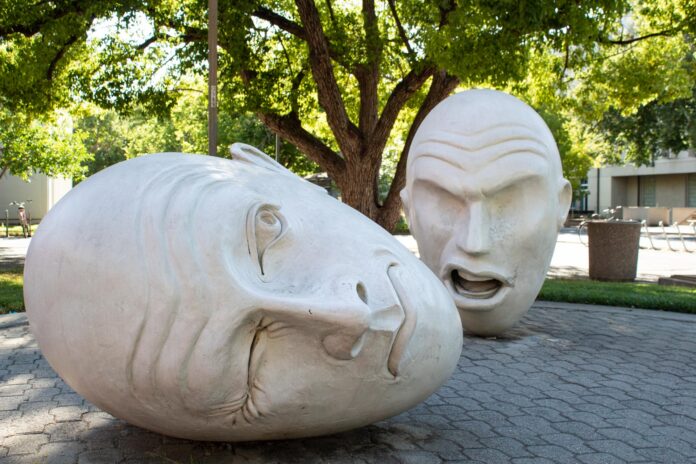Faculty members of UC Davis Library reflect on the history of the Eggheads and their impact on campus
Amid the structures that make UC Davis similar to other college campuses such as classrooms, dormitories and dining halls, the Egghead sculptures stick out as a Davis quirk. The Eggheads, which can be seen in five different locations, are art sculptures that were first introduced to UC Davis in 1991. Quite literally egg-shaped heads, the sculptures were created by late UC Davis ceramics professor Robert Arneson.
Kevin Miller, the head of Archives and Special Collections and the lead for the Archives and Institutional Assets Program as the university archivist, explained how the initiative to create the Eggheads came to be.
“Right towards the end of [Arneson’s] career at UC Davis, there was this group that was starting up, a campus committee called the UC Davis Art and Public Spaces Committee,” Miller said. “They worked with donor money to raise some money for some public artworks to beautify campus and make campus a little more unique. Arneson’s Egghead’s were a big part of that.”
Miller stated that while the concept of an “egghead” refers to someone who is highly academic or intellectual, the sculptures serve as an important reminder of UC Davis’ strong arts and humanities presence.
“In some ways it accomplishes both: it kind of points out that we’re a very serious school in terms of academics with a wide range of disciplines, but it also speaks to the important history of art on campus,” Miller said.
Moreover, Miller explained that it was important for Arneson that the Eggheads be hands-on and interactive, rather than roped off from the public. He wanted members of the community to “be able to go up to them, touch them, experience them.” UC Davis has fulfilled this wish, and anyone can approach the Eggheads. They have even become popular spots for graduation photos.
“Occasionally, there’ll be somebody scratching their name into one or something like that, but for the most part they’re beloved. They’re the subject of practical jokes that are done with love,” Miller said.
While the Eggheads reside on campus, Miller stated that they fused well with Davis as a city.
“It bled into the town as well, and maybe that was reciprocal because Davis as a town is also pretty well known for its kind of quirky public art,” Miller said. “So that was really nice for the town and college relationship.”
Lee Riggs, a library assistant in Student Services at Shields Library, appreciates the sense of humor and approachability of the Eggheads and how they incorporate fun into an academic campus.
“You can read your own story into each of them, but you can also see that they have their own story,” Riggs said.
Riggs shed light on the connections students have made with the different Eggheads over the years, such as the “Bookhead” which is located outside of Shields Library.
“The other thing that sticks in my head with the ‘Bookhead’ is that over time, people have decided that if you rub it before an exam, that will bring you good luck,” Riggs said. “I’ve actually heard campus tour guides say that, so that’s kind of a myth that has developed on its own.”
Jessica Nusbaum, the Director of Communications and Marketing at the UC Davis Library, described her opinion on the lasting impact of the Eggheads on UC Davis.
“I’m no art historian, but in my personal view as a member of the campus community, Robert Arneson’s Eggheads have become emblematic of UC Davis,” Nusbaum said via email. “Quirky, witty, challenging us to look at things in a new way—from the upside-down ‘Eye on Mrak’ to the library’s own ‘Bookhead’ […] the Eggheads are truly one of the university’s most visible and recognizable symbols.”
Written by: Nora Farahdel — features@theaggie.org





